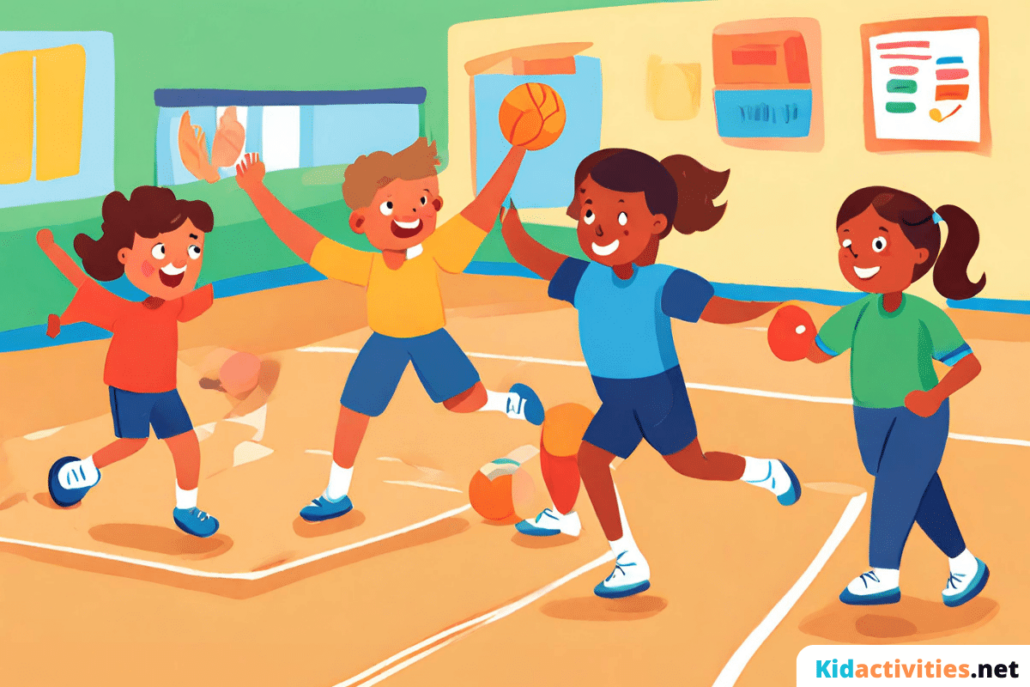Almost every elementary school curriculum includes physical education. Physical activity should be a regular part of children’s lives so they can develop their activity skills, motion, balance and overall physical fitness.
Physical activity not only helps children develop critical physical skills, but it also encourages healthy habits and improves educational performance.
To ensure that students receive a comprehensive physical education experience, it is important to have well-planned and engaging lesson plans. However, even experienced teachers find it challenging to design engaging and developmentally appropriate physical education lesson plans.
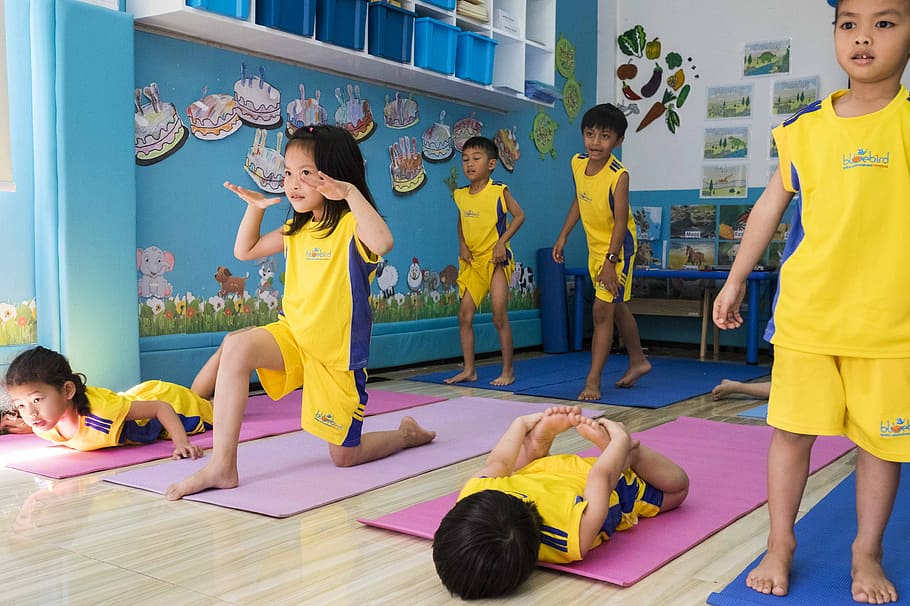
Fortunately, there are many resources available for teachers to create effective physical education lesson plans. A little creativity and planning can help teachers design lesson plans that incorporate a variety of skills and activities, and tailor them to their students’ skills and needs.
The goal of this article is to explore the fundamentals of physical education lesson planning for elementary students. Our goal is to provide an overview of the different types of lessons that can be used to engage students and develop appropriate fitness goals and objectives.
Whether you are a new teacher looking for inspiration or an experienced teacher updating your curriculum, this article will provide you with information and ideas that will make creating engaging and effective physical education lesson plans easier.
You will gain insights into how to integrate different types of activities into your lessons, from warm-ups to cool-downs. In general, this article will help you plan effective physical education lesson plans that will improve the physical skills of your students and improve their overall health and well-being.
Why Physical Education Is Important for Elementary Students?
There are several reasons why elementary students need physical education lesson plans. The first and foremost purpose of physical education is to promote physical health and fitness.
Children can maintain a healthy weight, develop strong bones and muscles, and reduce their risk of chronic diseases like diabetes, heart disease, and obesity by participating in regular physical activity.
Including physical education in the school day ensures that children get the exercise they require in order to stay healthy.
Besides promoting physical health, physical education lesson plans encourage children to develop motor skills and coordination. Practicing coordination and balance while running, jumping, throwing, and catching can help children develop a greater sense of body awareness and control.
Physical activity is also linked with mental development and consistency that’s why developing athletic skills at a young age can also help children perform better academically.
Social and emotional development is another skill that can be promoted through physical education lesson plans. Communication, cooperation, and teamwork are among the social skills that children can develop through group activities and team sports.
During these activities, children can gain new skills, achieve personal goals and build self-esteem and confidence.
It’s a common fact that fun and engaging physical education lesson plans can keep students motivated and active throughout the school day.
Let alone that teaching children how to remain engaged in physical activity can help them develop healthy habits that will last a lifetime.
List of Elementary P.E Activities for your Lesson Plan
1. Warm-Up Stretches
Warm-up stretches are an essential feature of any physical education lesson plan. The benefits of stretching before physical activity include preparing the body for movement, increasing blood flow to the muscles, and reducing the risk of injury. Warming up your students with stretches can also keep them engaged and motivated.
Your warm-up routine can be enhanced by teaching students different stretches and having them perform them in a circuit-style fashion. During a circuit-style warm-up, students rotate through different stretches or exercises, each performing the stretch or exercise for a set amount of time before moving on to the next.
Make sure your warm-up stretches target a variety of muscle groups and body parts. For example, you might do stretches for the hamstrings, quadriceps, calves, chest, shoulders, and neck. However, keep in mind that students should also be taught stretches that are appropriate to their age and skill level.
To make warm-up stretches more engaging add music to your warm-up stretches or incorporate partner stretches. Stretching with a partner can improve trust and teamwork skills for students, as well as provide a deeper stretch than stretching alone.
Stretching is a great way to prepare your students’ bodies for physical activity while also keeping them active and enthusiastic. Lastly, by teaching students the importance of warming up and stretching before any physical activity, you can help them develop healthy habits that they can carry into their future.
2. Fitness Circuit
Incorporating a fitness circuit into a physical education lesson plan is a great way to include a variety of exercises and activities. The intention of a circuit is to rotate through several stations, each focused on a different type of activity or exercise.
Here is an example of a fitness circuit for elementary students:
Station 1: Jumping Jacks
Students should perform 20 jumping jacks. By performing this exercise, students will improve cardiovascular endurance and strengthen their arms, legs, and core.
Station 2: Hula Hoops
Give students hula hoops and have them practice spinning them around their waists or performing tricks with them. This activity helps develop coordination and balance.
Station 3: Lunges
On each leg, have students perform 10 lunges. By performing this exercise, students will strengthen their legs and improve their balance.
Station 4: Jump Rope
Give students jump ropes and have them jump continuously for 30 seconds. This exercise boosts cardiovascular endurance and coordination.
Station 5: Push-ups
Have students perform 5 push-ups. This exercise is ideal for building up the upper body.
Station 6: Balance Beam
Set up a balance beam and have students practice walking across it or doing other balance exercises. This activity can improve balance and core strength.
Station 7: Sit-ups
Students should perform 10 sit-ups. This exercise helps strengthen the core.
Rotating through these stations will not only improve students’ coordination, balance, and cardiovascular endurance, but will also offer a full-body workout.
By increasing the number of repetitions or the amount of time spent at each station, you can make the circuit more challenging. If you feel that your circuit lesson plan becomes a bit boring you can switch out stations or use different equipment.
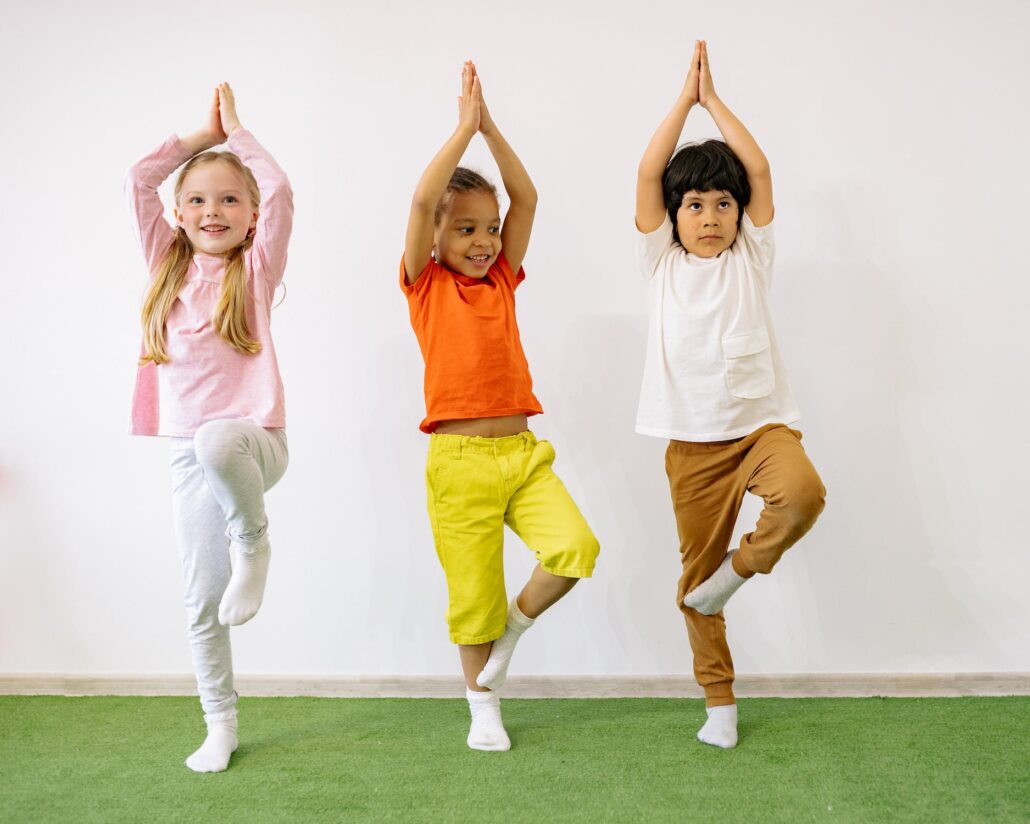
3. Yoga
Yoga poses can be a fun and engaging way to promote physical activity and mindfulness in elementary school students. It has been proven that yoga is beneficial to both mental and physical health, including increasing flexibility, strength, and balance, and reducing stress. Here is an example of a basic yoga sequence that can be used with elementary school students:
- Mountain Pose
Students should stand tall with their feet hip-width apart and their arms by their sides. Encourage them to take deep breaths and focus on grounding themselves in the present moment.
- Downward Facing Dog
In the downward-facing dog pose, students should come down on their hands and knees, then lift their hips up and back. Practising this pose is beneficial for stretching the hamstrings, calves, and spine.
- Tree Pose
Bring students into standing and have them rest one foot on the opposite thigh, pressing their foot into the thigh while bringing their hands to their heart centre. The purpose of this pose is to improve balance and concentration.
- Child’s Pose
Get students to come down to their knees and sit back on their heels, stretching out their arms. Practising this pose helps to release tension from the back and shoulders.
By introducing students to basic yoga poses and guiding them through a sequence, you can help them foster physical skills, mindfulness, and overall well-being. Let alone group yoga can also foster a sense of community and connection among students.
4. Tag Games
The classic and popular tag game is a great way to get elementary school students active. Chasing after and trying to tag their peers is an excellent way to promote cardiovascular endurance and coordination. The following are some examples of classic tag games that can be played with elementary school students:
- Freeze Tag
During freeze tag, one player is “it” and tries to tag other players. When tagged, a player must freeze in place until another player crawls between their legs to “unfreeze” them. The game continues until all players are frozen.
- Sharks and Minnows
In Sharks and Minnows, one or more players are designated as the “sharks” and sit in the centre of a selected area. The other players are the “minnows” and must try to run from one side of the area to the other without getting tagged by the sharks. In the event that a player is tagged, they become a shark and help on tagging other players.
- Blob Tag
In blob tag, one player starts as the “blob” and tries to tag other players. A tagged player must help tag other players by joining hands with the blob. As more players join, the blob grows bigger and bigger until every player has been tagged.
Elementary school students can have fun while improving their cardiovascular endurance, coordination, and teamwork skills when they play tag games. It is also possible to modify or change the rules of these games in order to make them suitable for different skill levels and group sizes.
Additionally, playing tag games can promote physical activity and exercise while also developing social skills like communication and sportsmanship.
5. Ninja Warrior Course
The Ninja Warrior Course is a challenging and exciting way to encourage physical activity and develop strength, agility, and problem-solving skills in young students.
The Ninja Warrior course is based on the popular television show American Ninja Warrior and can be set up indoors or outdoors, depending on the skill level and size of the group.
Some popular obstacles in a Ninja Warrior Course for kids involve balance beams, rope swings, cargo nets, monkey bars, and wall climbs. By setting up a Ninja Warrior course kids can build their confidence and skills gradually as they progress through the obstacles.
Elementary school students benefit physically and mentally from Ninja Warrior Courses. It is a great way to promote fitness and healthy habits, while also encouraging kids to challenge themselves and develop important life skills.
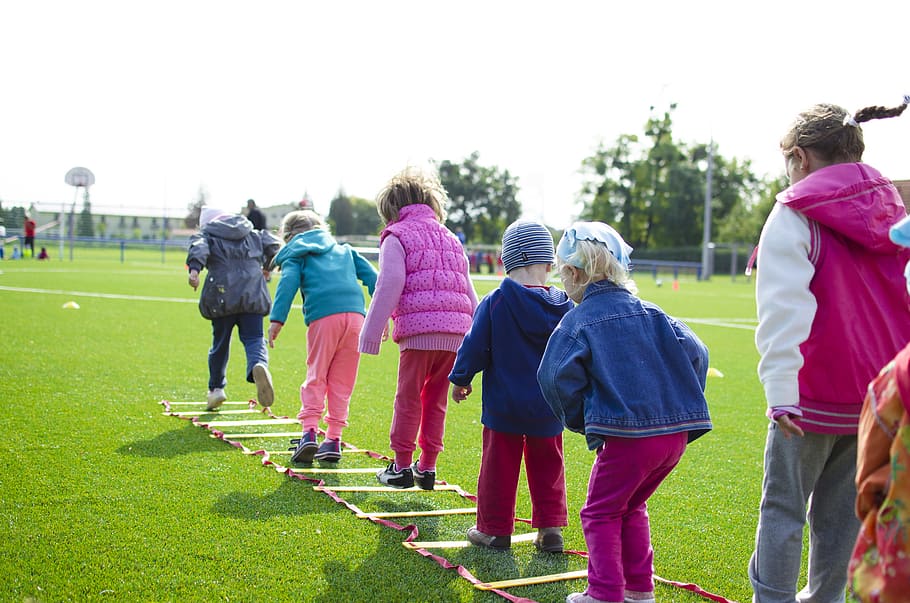
6. Football Skills
Football is one of the most favourite and adored sports of all time. Kids love to play and chase the ball; that’s why creating a P.E. lesson plan for football will excite students.
Football skills refer to the physical abilities and techniques required to play football effectively. These skills include passing, dribbling, shooting, and ball control, among others. Developing football skills requires practice, coordination, and physical fitness.
By improving their football skills, students can increase their enjoyment of the game and improve their performance on the field. Additionally, learning football skills can encourage physical exercise and healthy routines, while also building trust and teamwork skills.
Football Skills Lesson Plan Example
Materials: Footballs, cones or markers, goals or target areas.
Warm-up (5-10 minutes):
- Jogging: Have students jog around the field or designated area to get their heart rate up and warm up their muscles.
- High Knees: Have students jog in place while bringing their knees up to their chest.
- Butt Kicks: Have students jog in place while bringing their heels up to their butt.
- Side Shuffles: Have students shuffle to the left and then to the right, facing the same direction.
- Stretching: Have students stretch their legs, arms, and back.
Main Activity (30-40 minutes):
- Passing Drills: Divide students into pairs and have them practice passing the ball back and forth to each other. Encourage them to use the inside of their foot to pass the ball accurately.
- Dribbling Drills: Set up a course using cones or markers and have students dribble the ball through the course, using both feet to improve their coordination and control.
- Shooting Drills: Set up goals or target areas and have students practice shooting the ball into them. Urge them to use proper techniques, such as planting their non-kicking foot next to the ball and following through with their kicking foot.
Cool Down (5-10 minutes):
- Walking: Have students walk around the field or designated area to bring their heart rates back down.
- Static Stretching: Have students stretch their legs, arms, and back to prevent muscle soreness and improve flexibility.
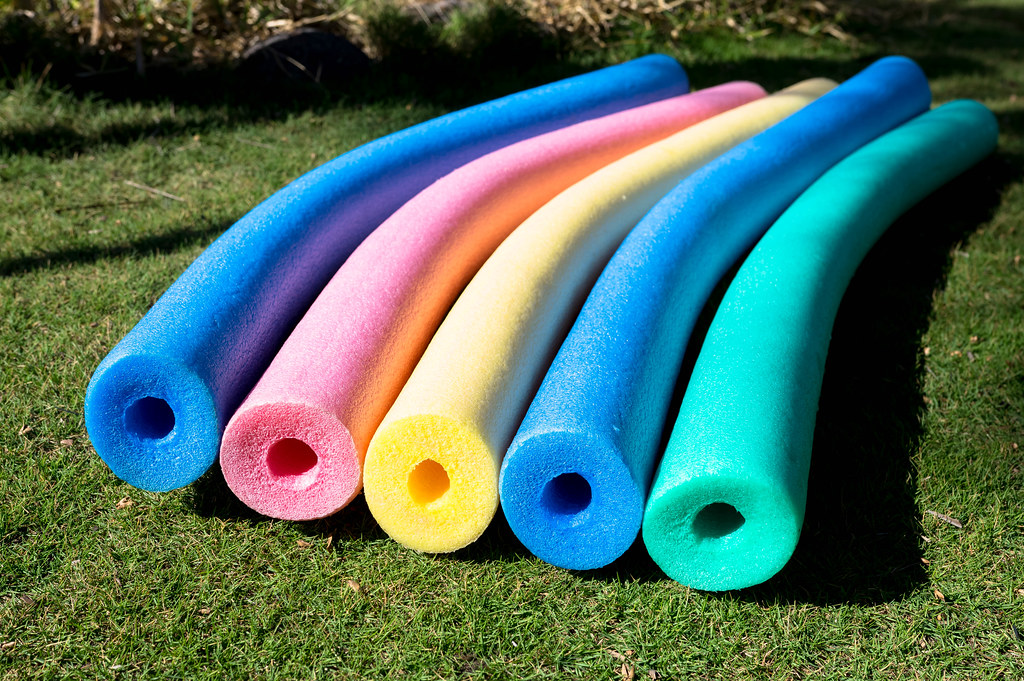
7. Noodle Hockey
The game of noodle hockey is a great way to expose children to hockey and help them build their physical fitness and agility. The soft and less rigid nature of pool noodles makes the game safer and less likely to cause injury; that’s why they are excellent for an elementary physical education activity.
In addition, the use of foam balls as the puck allows for a lighter and easier-to-handle object, making it accessible for young children to participate.
Including noodle hockey in elementary physical education courses or after-school activities can encourage communication and teamwork. The game provides children of all skill levels with a fun and inclusive environment for them to enjoy and develop a love of physical activity.
Noodle hockey is an excellent way to introduce children to the fundamentals of a popular sport while teaching them about staying active.
8. Balloon Tennis
Another enjoyable activity for physical education classes in elementary school is balloon tennis. Regardless of the season, physical education teachers can easily set up the game, use minimal equipment, and play it indoors or outdoors.
During balloon tennis, children can exercise and develop their motor skills, coordination, and reflexes while having fun. This low-risk activity uses a balloon instead of a ball, so children can learn the basics of tennis without being injured or frustrated by the traditional tennis ball and racket.
Furthermore, balloon tennis can be played in groups or pairs, allowing children to develop communication and teamwork skills. It is also possible to modify the game rules so that it is accessible to students of all skill levels.
In general, balloon tennis is a safe and fun way to teach children the fundamentals of popular tennis sport.
9. Fitness Dice
Fitness dice is a fun and interactive way to encourage physical activity in elementary schools. These large foam dice have different exercises and movements printed on each side, such as jumping jacks, lunges, and push-ups. Students roll the dice and then perform the exercise indicated on the side that faces up.
Fitness dice can be used in a variety of ways in elementary physical education classes. Teachers can use them as part of a warm-up routine or as a way to break up the monotony of traditional exercises. They can also be used in group activities or as a fun way to introduce new exercises and movements to students.
Using fitness dice in elementary schools encourages physical fitness and helps children formulate coordination, balance, and dexterity. Additionally, because the dice provide a variety of exercises, students can exercise different muscle groups and improve their overall fitness levels.
Fitness dice are also a great way to make physical activity more fun and engaging for children. They can be used as part of a game or challenge, and students can compete with one another to see who can complete the exercises the fastest or with the most accuracy.
Overall, fitness dice is a versatile and useful tool for boosting physical training and improving fitness levels in elementary schools. The foam dice exercise can provide a fun and interactive way for children to engage in physical activity and develop important motor skills and coordination.
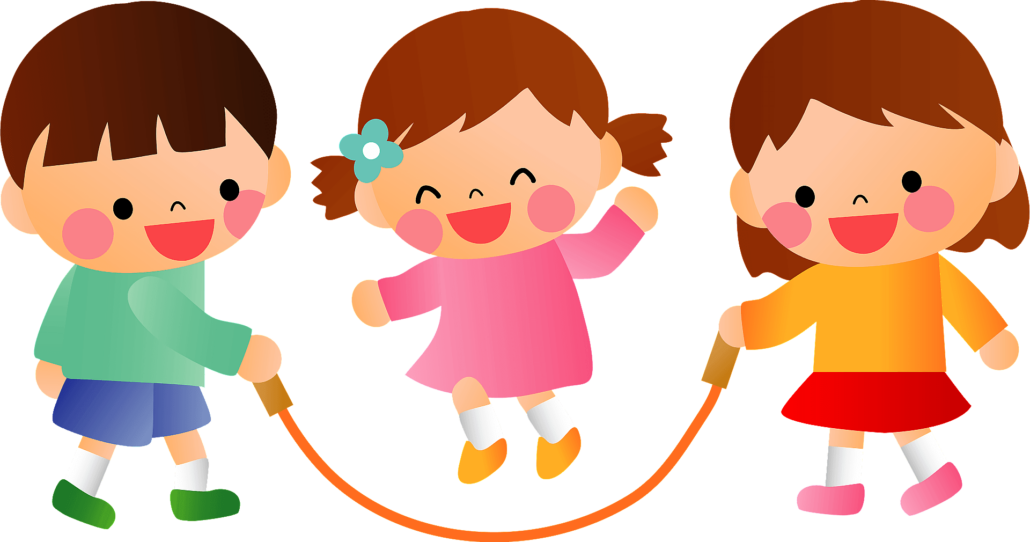
10. Jump Rope
Jump rope is a traditional and widely used physical exercise that can be integrated into elementary school physical education plans. Students can benefit physically and mentally by learning basic jump rope skills and practising in groups or individually.
The jump rope activity can improve students’ coordination, balance, and cardiovascular fitness. By playing this game – activity students can also gain a better sense of rhythm, timing, and spatial awareness. A fun and engaging activity like jumping rope can also help students relieve stress and improve their mood.
To teach elementary students jump rope skills, you should start with basic jumps such as the two-foot jump and then progress to more advanced jumps like the cross-over and double-under. To make the activity more exciting and varied, teachers can include jump rope games, such as Double Dutch.
It’s a versatile activity for all weather conditions, as you can game both indoors and outdoors. Additionally, the jump rope can be easily modified to suit different skill levels and abilities, making it accessible to everyone.
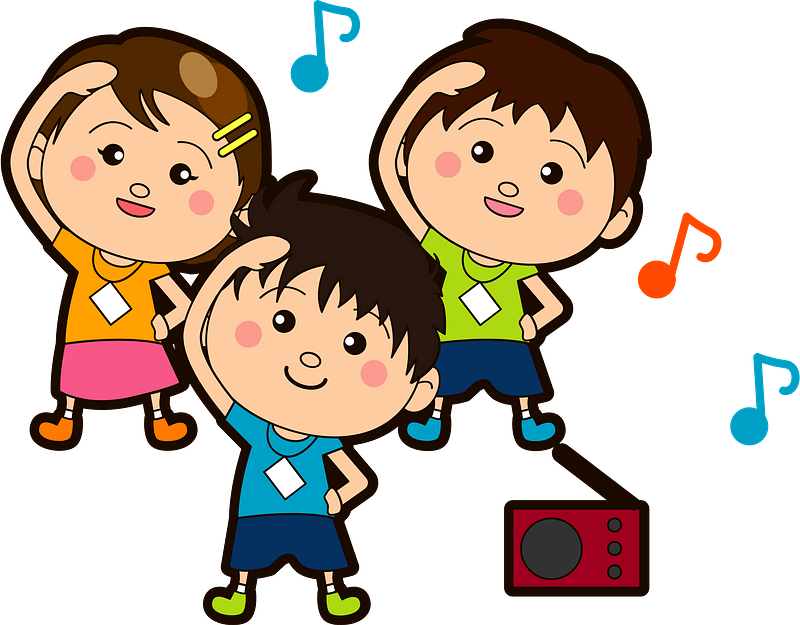
11. Dance
Including dance in an elementary school fitness education plan is an amazing way to inspire students to engage in physical activity while also delivering a fun and innovative source for self-expression. Introducing a simple dance routine and having students perform it together can offer a range of physical and mental benefits.
Dance delivers a full-body exercise that can improve cardiovascular fitness, strength, balance, and coordination. It can also improve flexibility, posture, and body awareness. Moreover, dance is an imaginative and expressive training that can assist students to build confidence, self-esteem, and social skills.
When teaching a dance routine to elementary students, it is important to choose music and choreography that are appropriate for their age. Teachers can also include different styles of dance, such as hip-hop, jazz, or ballet, to reveal students’ different workout/dance techniques.
Dance can be performed both indoors and outdoors, making it an adaptable activity that can be adjusted to all spaces. It can also be altered to suit different group sizes, making it an inclusive activity for all students.
In summary, mixing dance into an elementary school physical education plan is an excellent way to encourage physical wellness, creativity, self-expression, and social skills.
By teaching a simple dance routine and encouraging students to perform it together, teachers can help students improve their physical and mental well-being while also having fun.
12. Heads or Tails
Heads or Tails is an exciting and easy physical exercise that can be used by elementary school physical education teachers to get students engaged and active during class time. All that is needed to play this game is a coin and a list of physical activities for students to perform.
To play Heads or Tails, pairs of students are given a coin and take turns flipping it. If the coin lands on heads, the first student in the pair chooses an activity from the list and the pair performs it together. If the coin lands on tails, the second student in the pair chooses an activity.
The list of physical activities can be tailored to the age and skill level of the students and can include a variety of exercises such as jumping jacks, push-ups, squats, or lunges. By allowing students to choose their own activities, they are more likely to be engaged and motivated to participate.
Heads or Tails is a great way to get students warmed up and ready for other fitness lessons. It is also a perfect activity for days when there is limited time for lesson prep. Additionally, this game helps to improve coordination, balance, and other physical skills.
Heads or Tails is a simple and practical physical activity that can be used by elementary school physical education teachers to engage students and get them moving.
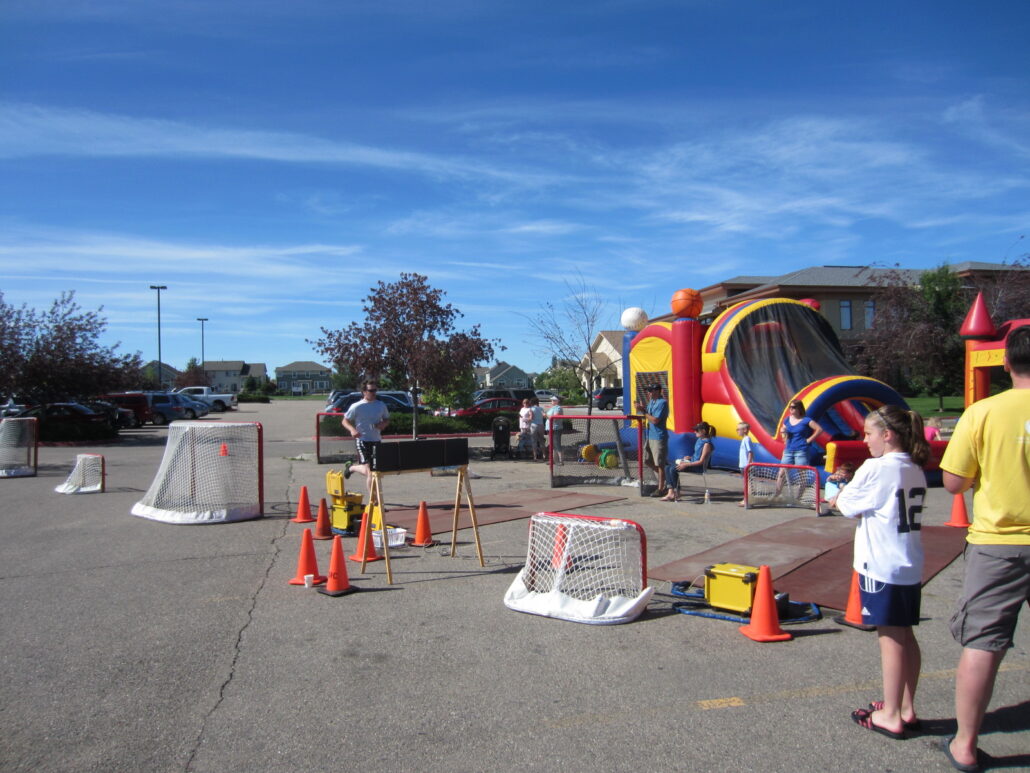
13. Cone Race
The cone race is a fun, engaging activity that is great for children in first grade and younger. By playing this game, students will improve their hand-eye coordination, motor skills, and colour recognition.
The activity involves placing cut-up pool noodles over tall plastic pipes or broom handles inserted into cones to hold them steady.
To play Cone Race, students are divided into teams and given a set of pool noodles that have been cut up into small pieces. The goal of the game is to match the coloured noodles with the corresponding cones. The team that matches all its noodles to the cones first wins.
For this fitness lesson, students must focus on their hand movements and the placement of the noodles as they place the cut-up pool noodles over the tall plastic pipes or broom handles.
A cone race is a great way to get young students moving and engaged in physical education. Regardless of class size or skill level, it is simple to set up and adaptable. Overall, the Cone Race is a great way to promote physical activity and help young children develop their motion and mental – thinking skills.
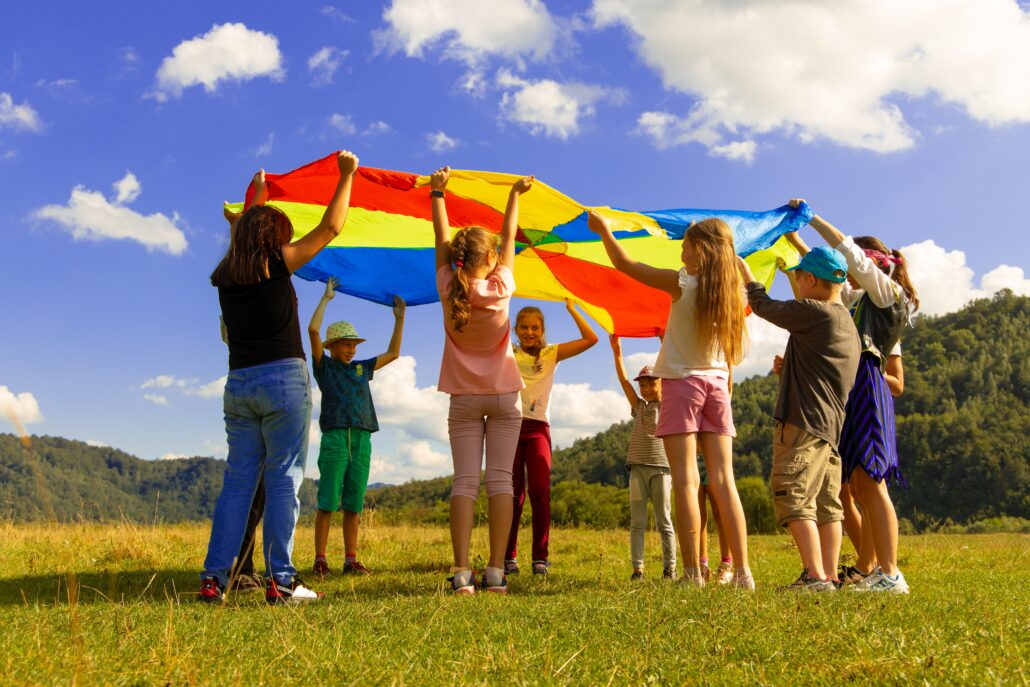
14. Parachute Fun
Parachute games are a fun and exciting way for elementary students to learn about teamwork, coordination, and motor skills. Here is a lesson plan for a parachute game that can be used in an elementary PE class:
Objectives:
- Students will learn to work together as a team.
- Students will develop gross motor skills.
- Students will have fun and stay active.
Equipment:
- Large parachute
- Balls or beanbags
Procedure:
- Warm-up: Have students stand in a circle around the parachute. Begin by keeping everyone hold onto the parachute with one hand and doing some light stretches with the other hand. Then, have them switch hands and repeat the stretches.
- Introduce the game: Present to the students that they will be playing a game with the parachute. Have them practice lifting and lowering the parachute as a group.
- Games
Game 1: Ball toss. Place some balls or beanbags in the middle of the parachute. Have the students lift and lower the parachute to toss the balls into the air and then catch them on the parachute.
Game 2: Parachute popcorn. Have the students lift and lower the parachute quickly to make the balls or beanbags “pop” up like popcorn.
Game 3: Switch sides. Divide the students into two groups and have them stand on opposite sides of the parachute. On the count of three, have each group lift the parachute and walk towards the other group until they have switched sides.
- Cool down: Have the students gather around the parachute and take turns saying one thing they liked about the game.
Variations:
- Change the number of balls or beanbags used in the games.
- Change the movements of the parachute (e.g., waving, shaking, twisting).
- Add in more complex games like “shark attack” where students must run under the parachute without getting tagged by students holding it.
Parachute games are a great way to get students excited about PE while teaching them valuable skills like teamwork and coordination. By incorporating fun and interactive games like these into PE classes, students are more likely to develop a lifelong love of physical activity.
15. Olympic-Style Events
Olympic-style events can be a great way to engage elementary students in physical education and teach them about the importance of sportsmanship, cooperation, and determination.
These events can be created to be age-appropriate and can be adjusted to suit the skill levels and capabilities of each individual student.
Some examples of Olympic-style events that can be integrated into elementary physical education lesson plans include relay races, obstacle courses, long jump competitions, and mini-triathlons.
Students can be teamed into groups and allowed to contest against one another, with medals or ribbons awarded to the winners.
In addition to the physical benefits Olympic-style events, can also provide an opportunity for students to learn about different countries and cultures.
The Olympics is a global event that brings together athletes from all over the world, and elementary students can learn about different countries and their traditions through classroom discussions and research projects.
Overall, Olympic-style events can be a joyful and fascinating way to encourage physical activity and teach important values to elementary students. By incorporating these events into physical education lesson plans, teachers can help students formulate a lifelong love of sports and physical fitness.
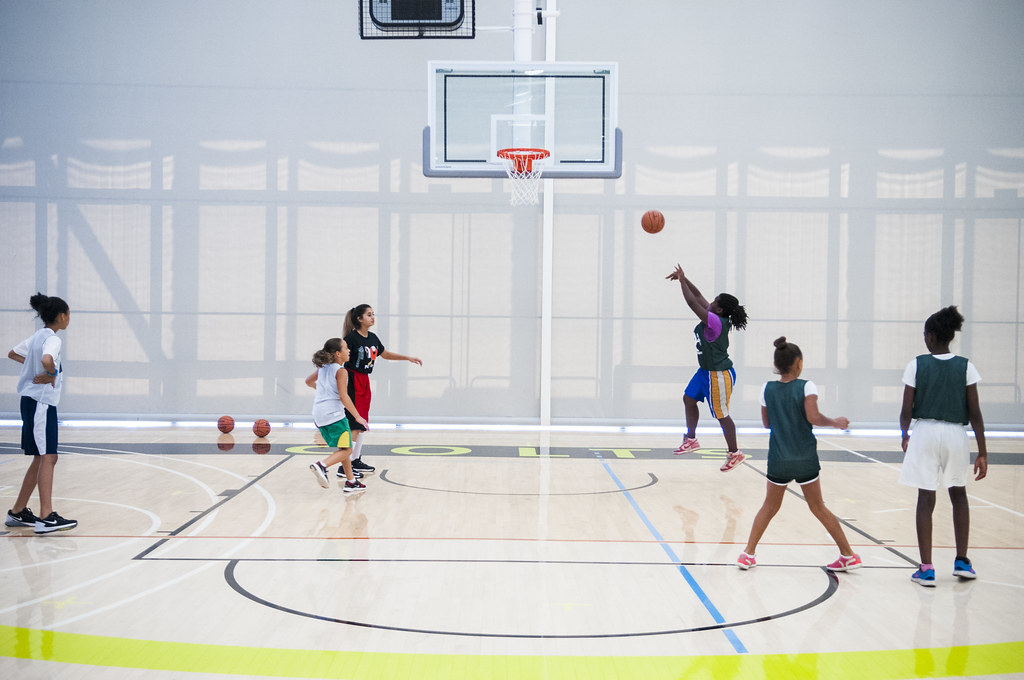
16. Basketball Skills
Basketball is a famous sport that can make students excited about physical education. Here are some basketball skills that can be integrated into an elementary physical education lesson plan:
- Dribbling: Familiarize students with the basics of dribbling, including proper hand placement and dribbling techniques. Have them practice dribbling in a specified area or through an obstacle course.
- Shooting: Introduce students to fundamental shooting techniques, such as the BEEF (balance, elbow, eyes, follow-through) approach. Have them practice shooting baskets from various spots on the court.
- Passing: Train students how to properly pass a basketball, including chest passes, bounce passes, and overhead passes. Have them practice passing to a partner or through an obstacle course.
- Defence: Teach students primary defensive techniques, such as guarding an opponent and blocking shots. Have them rehearse these techniques in one-on-one or small group drills.
- Gameplay: Separate learners into teams and have them play an altered game of basketball. Make sure to highlight the significance of good sportsmanship and teamwork.
By incorporating these basketball skills into a physical education lesson plan, elementary students can grow their coordination, teamwork, and sportsmanship skills, all while having fun and staying active.
17. Volleyball Skills
Volleyball is a famous team sport played worldwide, and it is also a great way to enhance physical wellness and develop teamwork skills. In elementary physical education classes, students can be introduced to the basics of volleyball and learn skills such as serving, bumping, setting, and spiking.
By incorporating volleyball skills into lesson plans, teachers can help students develop their hand-eye coordination, motor skills, and communication skills. Volleyball can be played with varying levels of intensity, making it adaptable for different age groups and skill levels.
Objectives
- Students will be able to execute basic volleyball skills such as passing, setting, and serving.
- Students will be able to work collaboratively with their peers to accomplish a common goal.
- Students will learn the importance of communication and teamwork in a sports setting.
Materials
- Volleyballs
- Cones to mark boundaries
- Nets
Warm-up
- Students will participate in a brief warm-up that includes jogging, jumping jacks, and stretches.
Skill Instruction
- The teacher will instruct students on how to perform basic volleyball skills such as passing, setting, and serving.
- Students will practice each skill individually, then work in pairs to practice passing and setting to each other.
Game Play
- Students will divide into teams and play an altered version of volleyball that concentrates on practising the skills they learned.
- Teams will work to pass, set, and serve the ball over the net to score points.
- The teacher will observe and provide feedback to students to help them improve their skills.
Cool-down:
- Students will participate in a brief cool-down that includes stretching and reflection on what they learned during the lesson.
Assessment:
- The teacher will assess students’ progress in performing basic volleyball skills during the gameplay portion of the lesson.
- The teacher will also assess students’ ability to work collaboratively with their peers and communicate effectively during the gameplay portion of the lesson.
Extensions
- For advanced students, the teacher can introduce more complicated volleyball skills such as spiking and blocking.
- Students can make their own individual versions of the game to practice various skills.
- The teacher can include a discussion about sportsmanship and fairness in sports.
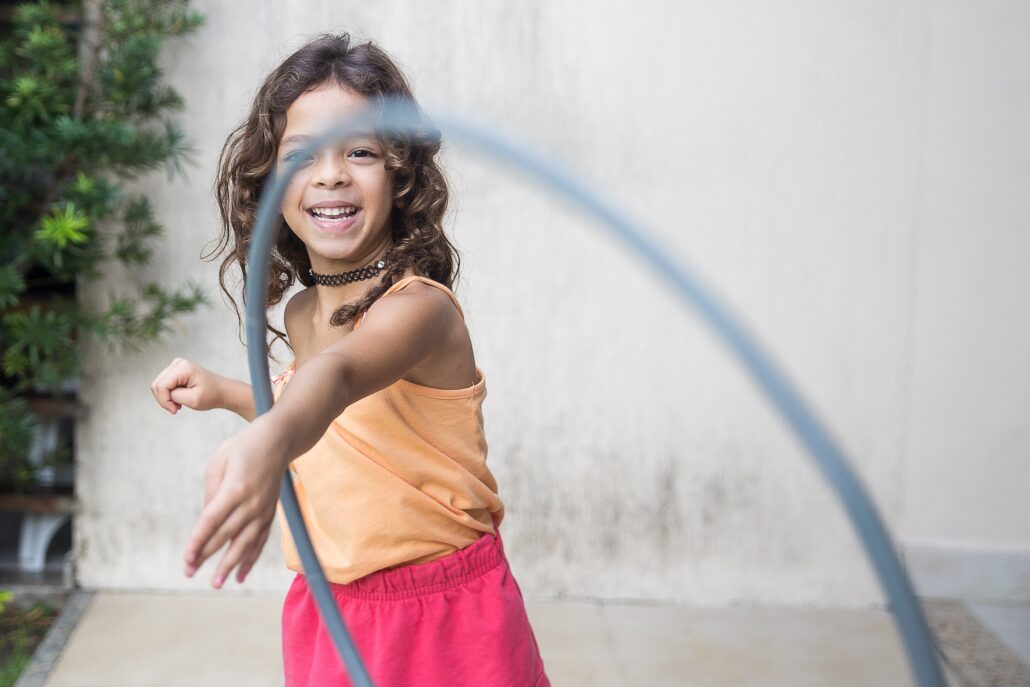
18. Hula Hoop
The Hula hoop is an adaptable object that can be utilised for a broad range of physical activities in elementary schools. It can help children develop their teamwork, balance, and motion skills, while also promoting cardiovascular health and endurance. In physical education classes, hula hoop games can be incorporated in many ways, including:
- Hula Hoop Relay
Divide students into teams and have them race to pass a Hula Hoop down the line as fast as possible. Each line of students stands in a line and holds a Hula Hoop. Upon receiving the signal, the first player passes the Hula Hoop to the next in line without letting go. The game continues until the last player in each line reaches the end and crosses the finish line.
- Hula Hoop Tag
This fun game twists the classic game of tag. To play the game Hula Hoops must be worn around students’ waists as they run around a designated area. The student who is “it” tries to tag the other students with their Hula Hoop. Students must also hold their own Hula Hoop once they are tagged and attempt to tag others.
- Hula Hoop Toss
An excellent game for developing hand-eye coordination. Each student tosses a Hula Hoop to a partner in a circle. A Hula Hoop must be kept moving around the circle without being dropped. If you want to make the game more challenging, try adding a second or third Hula Hoop.
- Hula Hoop Obstacle Course
Use Hula Hoops to create an obstacle course. In order to complete the game, the students finish the course without touching the Hula Hoops. This game is a great way to develop balance and agility.
Students can engage in physical activity and promote their overall health and well-being through hula hoop games and activities. In general, children can learn healthy habits that will last a lifetime by engaging in fun and exciting physical activities and moving their bodies.
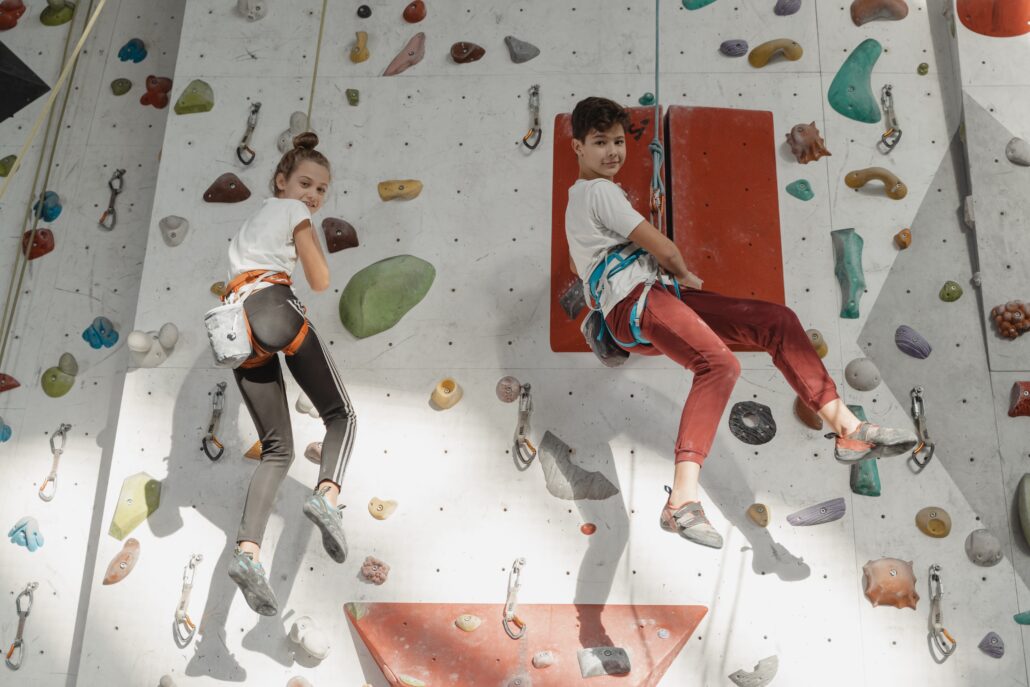
19. Rock Climbing
Rock climbing can be an exciting and innovative activity to add a physical activity lesson for elementary students. It’s an activity that not only boosts physical strength and endurance but also helps students to build their problem-solving skills.
One perfect way to introduce rock climbing to students is by adding to your course equipment a bouldering wall in the gymnasium or in an outdoor space. Start by teaching students the basic techniques of climbing and bouldering, like footwork and handholds, and progress to more difficult courses as they earn experience and confidence.
As a teacher, you can also use a portable climbing wall that can be easily set in any space. Those walls are made to be perfectly safe and user-friendly for children and can be adapted to all skill levels and ages.
However, keep in mind that this sport is a bit more dangerous and demanding that’s why proper supervision and equipment should always be in place. By using a climbing wall you will help students to develop both physical and mental skills.
20. Scooter Board Activities
Scooter boards are small boards with wheels that can be used for a variety of physical activities. Scooter board activities can be an innovative lesson to add to your physical education lesson plan as elementary students can be taught valuable skills like balance, coordination and teamwork skills. There are many scooter board activities that can suit all skill levels and ages.
Some famous scooter board activities are relay races, obstacle courses, and target games. For relay races, students can contest in teams and check who can finish the course in the fastest time, while also sitting or lying on the small scooter boards.
Obstacle courses can be set up using cones, hurdles, and other tools to challenge students’ balance and motion skills. Target games can include actions like rolling a ball or beanbag onto a target while seating on a scooter board.
Scooter board activities can be adjusted for all ages and skill levels. They are a versatile option for physical education teachers who are tired of using the same traditional games.
They can be utilises as an exciting break from classic sports and games, while still providing useful physical activity and skill development opportunities.

21. Sack Races
Sack races are a classic physical activity that elementary school students can participate in and have fun while exercising. This activity involves students standing inside a large sack or pillowcase and jumping toward a finish line.
A student wins the race if he or she crosses the finish line first. Everything is a matter of speed, balance and coordination skills
A sack race is not only a fun and entertaining activity, but it can also provide a number of physical perks. The purpose of sack games is to develop fine control skills, coordination, balance, and leg strength. The distance and size of the sacks can also be adjusted for students of different ages and skill levels.
For a more challenging activity, you can use obstacles such as cones or hoops and let students race through them. Relay races can also be incorporated, where students pass the sack to each other before sprinting to the finish line. Generally, sack races can be a great way to get elementary students active and involved in physical education.
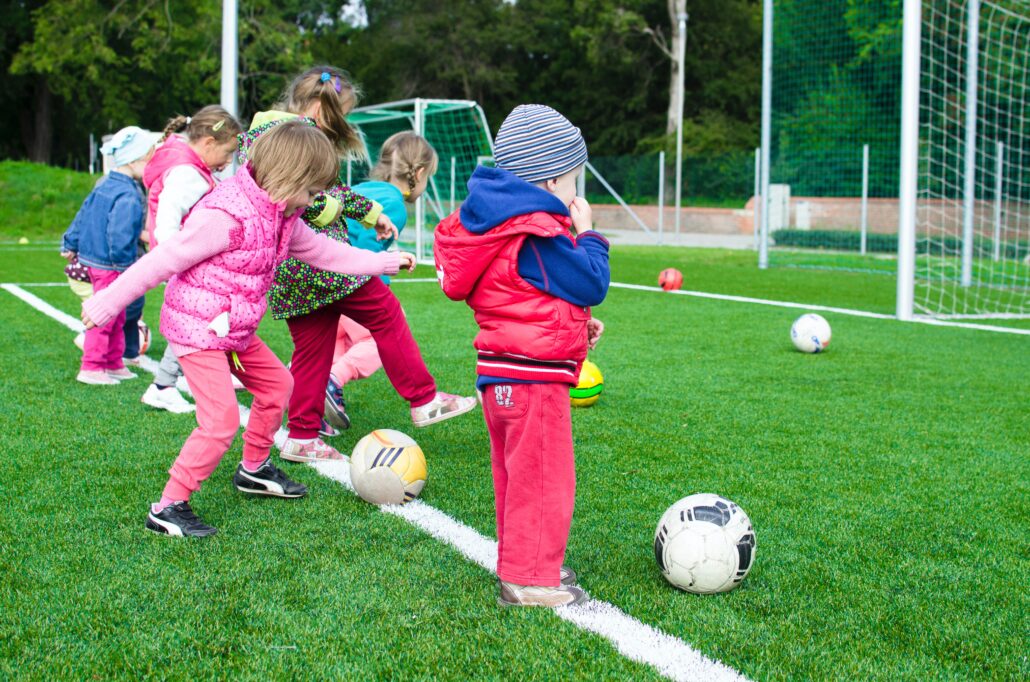
22. Kickball
Kickball is a traditional physical education activity that is used in elementary schools for years. Kickball is a simple twist of the classic baseball game.
The game involves kicking a large rubber ball instead of the traditional baseball one. The game is played outdoors with four bases and a pitcher, and the purpose is to score runs by running around the bases after kicking the ball.
Kickball is an amazing activity that helps students grow their fitness levels and physical skills, like strength and agility. It is a game that also promotes more personal skills like teamwork and sportsmanship, as students must play together to win the game while following the rules.
If you want to make the game more difficult there are plenty of variations that can be added. Apply some different rules for the base running or use different types of balls. Kickball games can be played in indoor and outdoor spaces making it an excellent choice for all elementary schools.
23. Wall Ball
Wall Ball is an easy and exciting activity for elementary school students that can be played both indoors and outdoors. It is an amazing way to enhance hand-eye coordination, throwing and catching skills, and overall fitness.
The game involves throwing a ball against a wall and catching it before it hits the ground or bounces off in an unexpected direction. Students can play this game individually or in teams, and the rules can be changed based on their age and skill level.
Wall Ball can be played with different types of balls such as tennis balls, rubber balls, or foam balls. It is an easy and accessible game that requires minimal equipment and can be adapted to fit the available space and resources.
Wall Ball also provides a chance for children to engage in friendly competition and practice sportsmanship. With the proper equipment and supervision, Wall Ball can be a safe and enjoyable activity for elementary students of all skill levels.
24. Topple Tube
Topple Tube encourages teamwork and strategic thinking through fun and engaging gameplay. Students must be divided into teams in order to play the game. Each team must flip its coloured cups to be on top of its opponents’ coloured cups in order to win the game. The cups are placed on top of tall poles or tubes, making it challenging for players to reach them.
In this game, two teams are formed, and each team is given a set of cups of a specific colour. Afterwards, the players scatter around the playing area, flipping cups to the colours of their teams. Depending on the equipment available, you can use either plastic cups or wooden blocks with different colours on each end.
In order to flip the cups effectively, the players must strategize and communicate with each other. To succeed in the game, they must also be quick on their feet and have good hand-eye coordination. By the end of the game, the team with the most cups flipped to the colour of their team wins.
The Topple Tube is an excellent physical education activity for elementary school students. As well as promoting physical activity and hand-eye coordination, Topple Tube promotes teamwork, communication, and strategic thinking skills.
25. Portable Balance Games
Portable balance games are a great way to challenge elementary school students’ balance and coordination skills. To play the games you only need some buckets in order to create the course and place them upside-down.
The upside-down buckets can be modified to fit students of all skill levels since they can walk along them at their own pace. If you want to make the activity more challenging, arrange the buckets in a zig-zag or curvy pattern. In order to navigate the bucket course, students will need to use their balance and gross motor skills in different ways.
Another great feature of portable balance games is that they can be positioned indoors or outdoors. As a result, it is an excellent option on days when the weather may prevent outdoor activities or for classrooms with limited space.
In addition, the buckets are a low-cost and convenient option for physical education lessons on a budget since they can be easily stacked and stored.
In conclusion, physical education is a critical element of a well-rounded education. It encourages physical exercise, teamwork, sportsmanship, and overall health and wellness. With the increasing prevalence of technology and passive lifestyles, it is more important than ever to foster children to engage in physical activity.
The 25 elementary physical education lesson plans listed above are just a few examples of the many activities and games that can be used to boost physical activity and learning. As an instructor though you can form your own lesson plans based on the requirements and interests of your students.
By making physical education fun and engaging, we can help children create a lifelong love of physical activity and healthy living. Let’s continue to prioritize physical education in our schools and communities, and encourage children to lead healthy, active lives.
